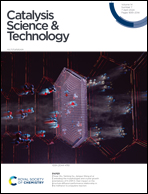Ambient conversion of CO2 and epoxides to cyclic carbonates using 3D amide-functionalized MOFs†
Abstract
Metal(II)-carboxylate frameworks are an important class of MOF materials finding applications in gas storage, separation, sensing, catalysis, etc. Recently, their design, synthesis and characterization have been established at a very fast pace. Here two novel MOFs based on 5,5′-(([1,1′-biphenyl]-4,4′-dicarbonyl)bis(azanediyl))diisophthalic acid (H4L, an amide containing ligand) and transition metals (copper and zinc) are reported. Several characterization tools e.g., FT-IR, XRD, SEM, TGA, and XPS are used to characterize these MOFs. Single-crystal X-ray diffraction and Hirshfeld surface analyses are used to characterize the 3D structural framework. The void and cavity analysis revealed the strength of the crystal packing. Both MOFs followed multistage thermogravimetric disintegration profiles. The solvent molecules escaped around 200 °C and the structural changes due to decompositions in the frameworks continued till 500 °C. The morphological analysis for Zn-MOF and Cu-MOF showed uniform wedge-shaped rectangular blocks and spherical balls with dimensions around 100 and 50 μm, respectively. The amide functionalized Zn(II)-carboxylate framework exhibited high catalytic activity (85–>99%) towards the solvent-free cycloaddition of CO2 to different epoxides e.g., epichlorohydrin, propylene oxide, allyl glycidyl ether and glycidyl isopropyl ether with 100% selectivity under ambient conditions (i.e., 1 bar at 40 °C for 24 h) at very low catalyst loading. By adjusting the reaction conditions (T, P, and co-catalyst), the catalytic conversion reached 100% within only 2 hours. The results showed Zn-MOF as a superior and efficient catalyst compared to other reported MOFs. Additionally, the catalyst can be easily recovered and regenerated for repeated use without performance loss.



 Please wait while we load your content...
Please wait while we load your content...